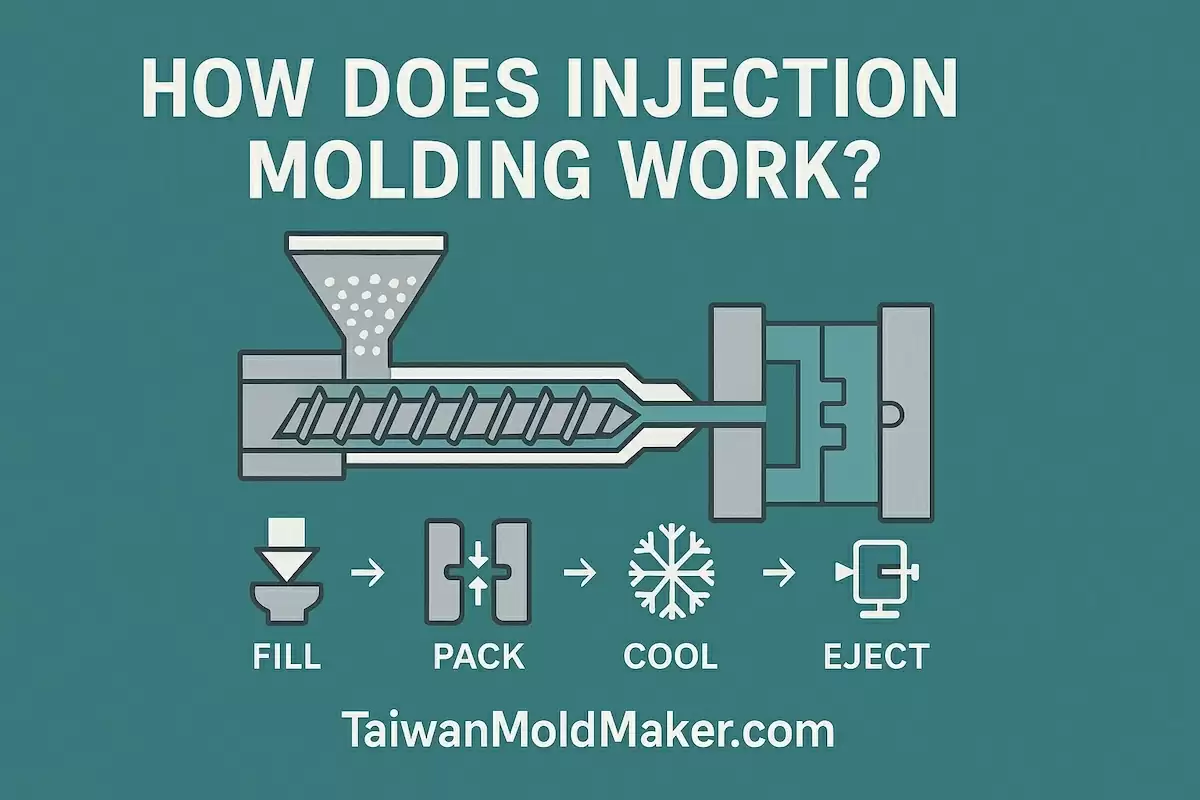How Does Injection Molding Work? Process, Design Rules & Cost Drivers
How Does Injection Molding Work? Process, Design Rules & Cost Drivers

How Does Injection Molding Work?
A Practical Guide from CAD to Packed Parts
Injection molding makes high-repeatability plastic parts by melting pellets, forcing the melt into a precision mold, cooling it into shape, and repeating the cycle—often millions of times—with stable quality and cost.
Core Idea (30 seconds)
-
Pellets in → melt made (plasticized by a screw/barrel).
-
Melt in → cavity filled (injection + packing through a gate/runner).
-
Heat out → part solid (cooling circuits remove heat).
-
Part out → next shot (open mold, eject, close, repeat).
Every improvement you make in mold design, gating, cooling, and process control shrinks cycle time and raises CpK.
The Equipment at a Glance
-
Hopper + Dryer – conditions hygroscopic resins (e.g., PA, PETG, PBT).
-
Screw/Barrel – melts and meters resin; back pressure and screw speed set homogeneity.
-
Nozzle – couples melt to the mold’s sprue or hot runner.
-
Mold (Tool) – steel/aluminum plates with cavity and core; includes gates, runners, cooling channels, vents, and an ejection system.
-
Clamping Unit – opens/closes the mold and holds it shut during injection.
-
Controls & Sensors – machine I/O plus cavity pressure and thermocouples for scientific molding.
-
Automation (optional) – robot demold, insert loading, inline mark/weld, vision SPC.
The Cycle (Step-by-Step)
-
Mold Close & Clamp
-
Machine builds clamp force to seal the parting line.
-
-
Injection (Fill)
-
Screw drives forward, pushing melt through runner → gate → cavity.
-
Fill speed/pressure set flow, shear, knit-line positions, and gate blush risk.
-
-
Pack & Hold
-
Extra pressure compensates shrinkage while the gate is still molten.
-
Critical for controlling sink, voids, and dimensions at CTQs.
-
-
Cooling
-
Most of the cycle time. Balanced cooling circuits extract heat until the gate freezes and the part solidifies enough to eject without distortion.
-
-
Mold Open & Eject
-
Ejector pins/strippers/air blasts release the part; robot retrieves; runners are trimmed or auto-degated.
-
-
Plasticizing (Recover)
-
Screw retracts and re-melts pellets for the next shot; dosing sets shot size.
-
Golden rule: set V/P transfer (velocity → pressure) using cavity pressure when possible—not just screw position.
Materials You’ll See Most
-
Commodity: PP, HDPE, HIPS → cost-effective, good flow.
-
Engineering: ABS, PC/ABS, PC, PA6/66 (±GF), POM, PETG → strength, heat, cosmetics.
-
High-Heat: PBT-GF, PEEK, PPS, PEI (ULTEM™) → harsh environments, E/E & auto.
-
Elastomers: TPE/TPV → soft-touch overmold, seals.
-
Additives: glass/mineral fill, FR (UL 94), UV, color MB, lubricants.
Mold Essentials That Make or Break the Part
-
Gates & Runners – size and placement drive shear, weld lines, pack, and vestige.
-
Cooling – channel diameter/depth/pitch and conformal cooling flatten ΔT and reduce warp.
-
Steel & Coatings – H13/S136/M300; TiN/DLC for glass-filled wear zones; SPI polish for A-class or optics.
-
Venting – micro-vents or vacuum help thin walls and prevent burn marks.
-
Ejection – guided ejectors/strippers prevent scuffing and knocks on ribs/bosses.
Design-for-Molding (DFM) Cheatsheet
-
Uniform walls; ribs at 40–60% of wall to avoid sink.
-
Draft: ≥1.0–1.5° textured; ≥0.5° polished faces.
-
Bosses: ID ≈ 60–70% of OD; fillet bases; rib tie-ins.
-
Living hinges (PP): hinge thickness 0.25–0.50 mm, flow across hinge.
-
Gate away from A-class; use fan/film on large skins; sequential valves for long flow paths.
-
GF materials: align gate/flow with load paths to control warp and fiber orientation.
Quality, Data, and “Scientific Molding”
-
Cavity pressure defines V/P transfer, pack time, and window robustness.
-
DOE (fill speed, melt/mold temps, pack profile, cooling) maps the stable process.
-
Metrology first: FAIR + CMM/blue-light scan, GR&R at CTQs; ΔE/gloss for branded surfaces.
-
SPC & MES: live OEE, CpK, scrap, energy (kWh/kg) with genealogy to lot level.
Common Defects → Fast Root Causes
| Symptom | Likely Cause | First Fixes |
|---|---|---|
| Short shots | Low melt temp / small gate / poor vent | Raise melt/mold temp; enlarge gate; add vents |
| Sink at bosses | Starved pack / thick mass | Increase pack; core heavy bosses; ribs 40–60% |
| Warp/flatness | Uneven cooling / fiber bias | Balance cooling; conformal inserts; move/sequence gates |
| Weld line weakness | Cold fronts / high glass | Raise mold temp; fan gate; sequential valves |
| Blush/jetting | High shear at gate | Larger gate; shorter land; hotter mold; slower initial fill |
| Splay/voids | Moisture/air | Dry resin; check check valves and vents |
Cost Drivers (What Buyers Should Watch)
-
Tooling complexity (actions, 2K/overmold, hot runner brand/valves).
-
Cavity count & balance (directly impacts piece price).
-
Cycle time (cooling rules).
-
Resin grade (GF/FR/UV add cost & wear).
-
Scrap & rework (vision SPC helps).
-
Post-ops (paint, laser, weld, assembly).
From Prototype to Production: A Typical Path
-
Upload CAD + targets (tests, resin, volumes).
-
48-Hour DFM Pack – gating/cooling map, risk register, cycle & CPU model.
-
Quick-turn tool (aluminum or hybrid) → T0/T1 DOE, cavity-pressure curves.
-
FAIR + functional/cosmetic checks → refine.
-
Copy-cavity to steel; add automation & vision; qualify (PPAP/IQ-OQ-PQ).
-
SOP with MES guardrails and PM schedule.
FAQs
Is 3D printing enough before tooling?
Great for concept fit, but only molding reveals true resin behavior, weld lines, and gate/cooling effects.
What’s a realistic tolerance?
Many CTQs land in ±0.05–0.10 mm on small/medium parts; micro-features tighter with the right steel and process.
When do I need a hot runner?
Multi-cavity, cosmetic surfaces, or long flow paths—valve gates cut stringing and improve balance.
What We Do (TaiwanMoldMaker.com Network)
-
Design & Tooling: aluminum → hybrid → full steel; valve-gated hot runners, conformal cooling.
-
Processes: 2K/overmold, thin-wall, optics, LSR, gas-assist, RHCM.
-
Quality: ISO 9001 network; IATF 16949 / ISO 13485 available; FAIR/CMM/GR&R/PPAP.
-
Automation & Data: robots, in-cell finishing, vision SPC, MES dashboards for OEE/CpK/scrap/energy.
Quick Links
-
Custom Mold & Design Maker – rapid DFM & tooling strategy
https://www.taiwanmoldmaker.com/product/custom-mold -
Mold Service – aluminum, hybrid, and steel tooling
https://www.taiwanmoldmaker.com/product/mold-service -
Injection Mold – materials & processes overview
https://www.taiwanmoldmaker.com/product/injection-mold -
Molding – automated production with traceability
https://www.taiwanmoldmaker.com/product/molding -
Customer Examples – case snapshots and results
https://www.taiwanmoldmaker.com/product/customer-examples
Call to Action
Ready to turn CAD into repeatable molded parts? Send your files and targets to receive a 48-Hour DFM & Cost Pack with a gating plan, cooling concept, cycle model, and timeline.
Request an Instant Quote → https://www.taiwanmoldmaker.com/contact








